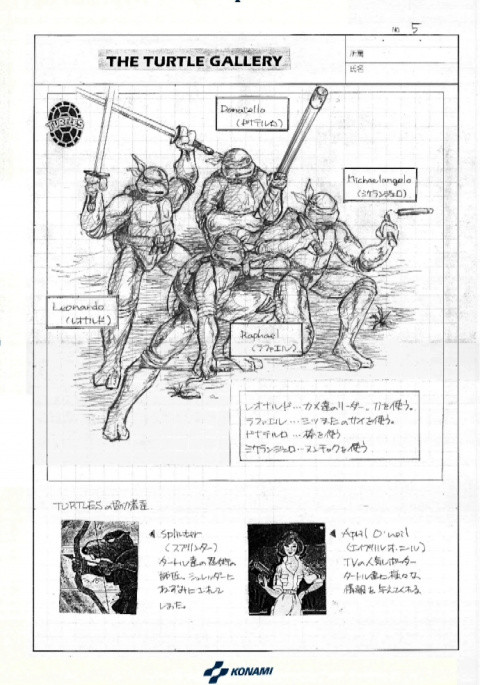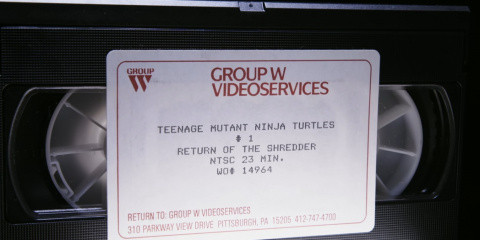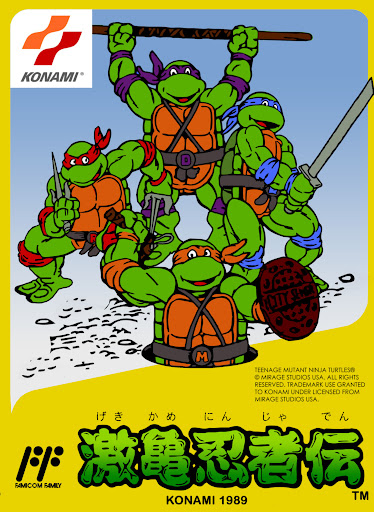Cowabunga! At the beginning of the 1990s, a television advertisement appeared on the screens of French homes and caused a sensation! Inherited from the American spot, the thirty-second advertisement announces the arrival of the Ninja Turtles on the Nintendo console. Sold separately or supplied as a pack with the machine, the game will become an essential NES classic! A few days ago, the legendary cartridge celebrated its 35th anniversary and we couldn’t miss this little event.
It’s impossible not to feel a certain nostalgia (if you knew that era) while watching This advertisement. On the musical theme of Ninja Turtles, we see Michelangelo, Donatello, Raphaël and Leonardo sink into the cartridge port of the NES to beat the members of the Foot Clan as well as Bebop, Rocksteady and Shredder. Everything is interspersed with sequences from the game and we already imagined ourselves braving the obstacles with the Knights of Scales.
Of all the versions available at the time on consoles and computers, Teenage Mutant Hero Turtles (and not Ninja due to a decision by the British government) is, by far, the best-known adaptation and the one which crystallized millions of memories. Developed by the Japanese studio Konami, the adventure combines action, platforms and exploration in a city plagued by the misdeeds of the Foot Clan. Rarely for the time, we control not just one character, but four! You can switch from one to the other at any time to take advantage of the different weapons. Leonardo and his katanas, Raphaël and his saïs, Donatello and his bō or Michelangelo and his nunchakus… there is something for all styles! The originality of such a system is that the player’s lives are materialized by the turtles. If the gauge runs out, you lose your hero and Game Over occurs as soon as your four turtles are curled up in their shells.
Turtle soup

No one has forgotten the level of the dam and the bombs to defuse!
Teenage Mutant Hero Turtles is considered one of the most difficult games of this period and it is not an urban legend. The inertia of turtles is not easy to master and certain passages have become cult precisely because of their demands. It is enough to cite the level of the dam (in the Hudson River) or post an image of the passage of electric algae to bring back memories… or nightmares. This damn level of bomb defusing sent more than one controller flying into the scene! And yet, Teenage Mutant Hero Turtles was so hypnotic that we kept coming back to it, the atmosphere and the production doing the rest. Whether you play as Leo, Raph, Mike or Don, Konami’s game exudes an atmosphere that is difficult to describe. And for years, no one knew who was behind such a creation. It is ultimately an alignment of the planets which allowed us, in 2022, to know more about the behind the scenes of TMHT on NES!
That year, Konami released the compilation TMNT: The Cowabunga Collection bringing together no less than thirteen Ninja Turtles games. Rated 16 out of 20 by yours truly, this game offers careful design, customizable options and an exceptional Museum mode. In this mode entitled “Turtle Hideout”, the developers have brought together the boxes and manuals, the advertisements and catalogs, photos of the animated series, the music, the strategy guides and… absolutely exceptional conceptual documents!
Behind the scenes of the Ninja Turtles game
For years, no one could tell who was behind the Ninja Turtles game on the NES. At the time, Japanese developers were required to hide their identities so that they would not be found by headhunters. Very often, designers used pseudonyms and it was almost impossible for the competition to pilfer talent from a successful company. Sometimes the creators weren’t even credited! This is the case of the game Ninja Turtles on NES and this is why the staff in charge of the game remained secret for so long. And then, at the turn of a video posted on his YouTube channelvideo game historian Florent Gorges has revealed some exciting information about Teenage Mutant Hero Turtles.
In the TMNT The Cowabunga Collection compilation, all the design documents are translated and we can thus compare the sketches with the final levels of the game. However, as exceptional as they are, these documents do not provide all the information on the development of the title, starting with the name of the designers. In his video, Florent Gorges reveals that he had the chance to meet Nobuya Nakazato, a historic personality at Konami. This designer, now a producer within the Japanese company, began his career with the Ninja Turtles game on the NES. He joined the game’s development team in 1988 and was one of two designers (the other person was nicknamed Shena Urata). In charge of the characters and several bosses, he managed to exploit the technical limitations of the console so that each protagonist is recognizable. You only need to take a look at the different sketches to realize that this adaptation of the comics by Kevin Eastman and Peter Laird was really taken seriously.
A surprising inspiration?

Produced by a core group of four to five people, the game had a fairly strict schedule, so much so that the staff obtained support from colleagues to meet deadlines. Florent Gorges also provides more information on the names of those involved in his video. And where it gets funny is when we learn that the main inspiration for the Ninja Turtles game comes from… the test pilot of the animated series! ”’At the time, the comic existed and there was talk of making it into a cartoon, but in 1988, it was only in its infancy.” And this is precisely the question in the documentary series The Toys That Made Us on Netflix.

The development team received a video tape to make the game.
It was in 1987 that everything began to take shape, on a marketing level, for the work of Eastman and Laird. The idea was to create a cartoon and use it as a springboard to sell Ninja Turtles toys and other figurines. From this initiative will be born a 5-episode mini-series. Unlike the original work, the tone was more cartoonish and many changes were made to differentiate each turtle: a colored headband for each of them, a belt buckle with their initial and a well-defined personality ( with a leader, a clown, a geek, etc.). The very first appearance of this animated series initially took the form of a video cassette bringing together various sequences for a total duration of five minutes. This video aimed to convince buyers (toy stores, etc.) of the interest in Ninja Turtles and the figurines in preparation.
In parallel with the creation of the toys, the Murakami-Wolf-Swenson studio (MWS Inc.) created the mini-series in 5 episodes and it was broadcast from December 28, 1987. In view of this information, we could believe that the video cassette sent in 1988 to Konami Japan contained this mini-series. This is all the more true as we find sequences that echo the game: the kidnapping of April, her rescue, the transformation of Bebop and Rocksteady (and therefore their animal form), the kidnapping of Splinter, the robots, the technodrome, etc. There is still a major anomaly: the mini-series contained the Ninja Turtles theme music… and it does not appear at any time in the game on NES. Therefore, are we to believe that the video cassette sent to Konami… is the five-minute one which was intended to convince buyers? Nobuya Nakazato talks about a pilot episode and the developers could have extrapolated from this short video. Intrigued by this affair, your servant began to do extensive research on the web and in particular in old American magazines.
If this warrants confirmation, it seems that the Ninja Turtles video game on NES is fully inspired by the fifth episode “Shredder & Splintered”. Titled here “A real ninja fight”, we discover that Shredder has a weapon capable of suppressing the effects of mutogen. By seizing it, Splinter can therefore return to his human form, namely that of Hamato Yoshi. The problem is that this weapon can be terrible for turtles since it can turn them back into tiny, harmless turtles.

On this document from the compilation, we can see photos of the toys used by the developers.
It is by immersing themselves in this scenario, but by removing the brain of dimension X, Krang, that the developers have obviously designed this adaptation. Moreover, if we visualize the end of the game (we’ll let you discover it unless you don’t want to spoil yourself), it totally echoes this episode! Furthermore, the turtles become very small again and curl up during Game Over. Finally, the fifth episode of the initial mini-series is the only one to feature the modified design of the Turtles’ van (initially, it is just a classic van, without any particular sign). Looking at the concept documents for the TMNT The Cowabunga Collection compilation, we also discover that the developers used photos of the very first toys marketed at Toys’R’Us in June 1988, as can be seen in the concept documents.
In turn, we can therefore deduce that the pilot episode was “Shredder & Splintered” and that the musical theme was not implemented when the video cassette was sent to Japan. Jun Funahashi, the composer, and Hidenori Maezawa, the sound programmer, then brought melodies with Asian tones in reference to Splinter’s origins. With the success that we know, since the themes have remained engraved in the memories.
An unexpected trip to Japan?

Needless to say, at the time, in 1988, the Ninja Turtles absolutely did not have the popularity that they would have a few years later. Therefore, for Konami, the creation of this game was a real gamble and the developers themselves had never heard of these characters. Developed in six months at Konami’s premises in Kobe, Teenage Mutant Hero Turtles is a cult game and will remain so. First intended exclusively for Western countries, the game was finally released in Japan under the name Gekikame Ninja Den (The Legend of the Intrepid Ninja Turtles) and the scenario was slightly modified with April O’Neil becoming… Splinter’s daughter. This game, appreciated by many NES owners, has sold more than 4 million copies and could only become, with its quality graphics, its rhythmic music and its anthological sequences (yes, always the barrage), an unforgettable NES classic. 35 years later, its reputation, like its difficulty, remains intact.
To know more :
Sources :
- Who created the first Ninja Turtles on NES???
- TMNT Compilation: The Cowabunga Collection
- Official Japanese page for the game Gekidame Ninja Den on Virtual Console
- Toys That Made Us – Netflix – Documentary on the Ninja Turtles series
